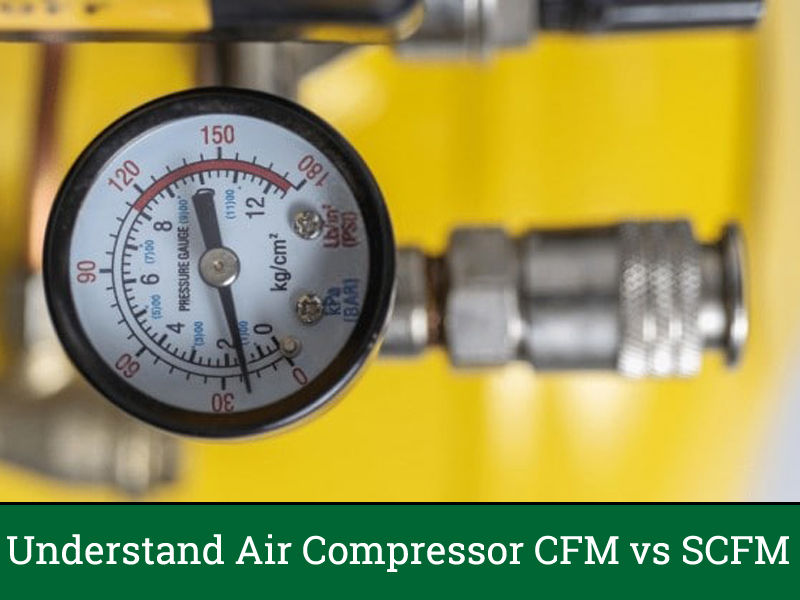
Understand Air Compressor CFM vs SCFM the Easy Way!
Disclosure: This post may contain affiliate links, meaning if you decide to make a purchase via my links, I may earn a commission at no additional cost to you. See my disclosure for more info.
Decades ago, mechanical systems comprising of shafts, belts, pulleys, and wheels, were commonly used as the central power source. As technology began to make its way into the world rapidly, the electrical system began to take the place of the mechanical ones. Today, many of these mechanical systems such as belts-and-pulleys, and shafts have their electrical replacement. There is one system that still stays in use today, and that is an air compressor-powered system!
The market is flooding with a variety of different air compressors. Each of the units that are available offer a unique set of features and have different applications. When choosing an air compressor, it is vital to have a thorough understanding of various ratings such as cubic feet per minute – CFM, Standard cubic feet per minute – SCFM, pounds per square inch – PSI, gallons, and duty cycle. These units determine the function of a compressor.
Air compressor CFM (cubic feet per minute) and SCFM (standard cubic feet per minute) are both measurements of airflow. However, they differ in the conditions under which the measurements are taken. CFM is the volume of air flowing out of the compressor at a given time, while SCFM measures the volume of air at standard conditions, which takes into account temperature, pressure, and humidity.
Table of contents
While understanding the initial differences is a little bit confusing if you read on we will try to de mystify these common terms for you.
Units for Evaluating an Air Compressor
The most common units for measuring the airflow of a compressor are CFM and SCFM. These are the two most highly-technical units for airflow measurement.
Before anyone invests in a system, they need to understand and carry out an air compressor CFM vs. SCFM comparison.
Cubic Feet per Minute – CFM
Cubic feet per minute or CFM is the volume of air that a compressor delivers to an air tool. It is a unit of measurement of a compressor’s capability. It plays the most important role during the evaluation of a compressor.
The higher the compressors CFM rating is, the better it will be able to handle heavy jobs. It is the unit of measurement of airflow for systems in which the air’s temperature and pressure are unknown.
It is crucial to base the choice of a compressor over CFM. Determining the requirement of CFM is not a very complex task. When you know the power requirement of the tool you want to operate using the compressor, you can determine the requirement of CFM.
A wise option in this regard is to opt for a compressor with a higher than required CFM value so that one can use it in the future for heavy-load application.
An air compressor’s CFM depends upon pounds per square inch. The CFM an air compressor delivers at 45psi will not be equal to the CFM delivered at 90psi. It is not be confused that an air compressor offering a specific CFM at 100psi will provide a higher CFM at 90psi.
Standard Cubic Feet per Minute – SCFM
Standard cubic feet per minute or SCFM is also a common unit of measuring the volume of air an air compressor can deliver to a tool. However, the difference between CFM and SCFM is that SCFM is measured in a controlled environment with known temperature, pressure, and relative humidity. Unlike SCFM, CFM is the measurement of the volume flow rate of a system where temperature and pressure are variables.
SCFM is measured at standard conditions, which allows measurement of mass flow rate. Mass flow rate is the amount of substance that passes through a surface at a specific unit of time. It is a realistic form of measurement, where as CFM is an idealistic form of measurement.
SCFM takes into account all essential factors such as atmospheric pressure, ambient air pressure, humidity, and temperature.
Role of CFM and SCFM in Evaluating an Air Compressor
The manufacturers provide the CFM and SCFM ratings. These ratings are measured at sea level. SCFM tells an air compressor’s volumetric flow at a standardized condition while there are no standards for CFM.
A CFM rating of an air compressor is always lower than its SCFM. The reason behind it is that a manufacturer measures the CFM of a compressor at a pressure lower or equal to 90psi, which is a reason behind a smaller air volume.
On the other hand, the air compressor manufacturers expand the air to a standard condition while taking into account the variables. The consideration of variables is, 68 degrees Fahrenheit, 14.7psi, and 36% relative humidity.
The ideal way to choose an air compressor is to determine the requirement of the tools and multiply the value by 1.5. This will give you an expectable margin of error that will guarantee that your tools will work as well as allowing you to purchase different air tools that may need a higher air requirement.
Final Thoughts
Hopefully after reading our guide you will have a better understanding on how the CFM and SCFM measurements are calculated.
If you would like to read some more about the terms that are used when discussing air compressors then we encourage you to have a look at our more resources articles.
More Resources
We hope you found our article helpful, if you would like to read some more of our articles then we think these below may be interesting for you.
